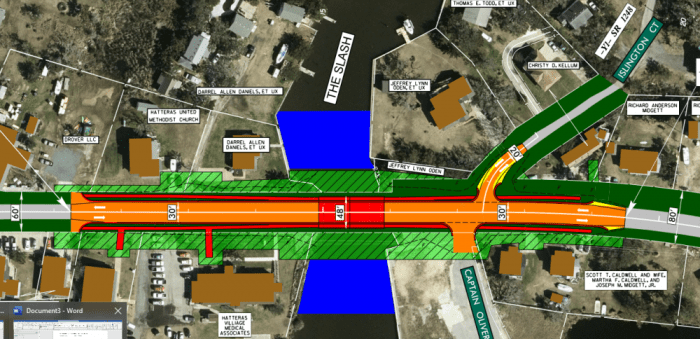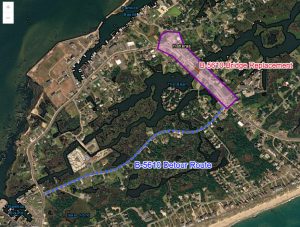
Representatives from the North Carolina Department of Transportation (NCDOT) and engineering firm Stewart were on hand at a public meeting on Thursday evening to discuss the new plans for the Slash Creek Bridge replacement, formally known as Hatteras Village’s Bridge No. 8.
The open house-style meeting garnered dozens of local attendees who were directly or indirectly impacted by the project and who had many questions for the designers and representatives congregated in Hatteras village.
Originally built in 1956, the current 86-foot-long bridge in the heart of the village was determined structurally deficient in an NCDOT inspection report. Structurally deficient bridges are considered safe for the time being, but have components in poor condition due to deterioration, and require significant maintenance or a full replacement to remain in service.

The proposed replacement bridge will include two 15-foot lanes and five-foot sidewalks on each side. During the roughly year-long project, (scheduled to start in the fall of 2023), an off-site detour on Eagle Pass Road will be used during construction.
The October 2022 design unveiled at Thursday’s meeting is the second draft of the bridge plan, and was created after conversations with the folks who live next to the bridge project, and whose properties are most impacted.
“This is the updated version, based on the previous commentary that we received about the [original] design,” said Ryan Eldridge, Transportation Planner for Stewart. “With the new design, there will be no anticipated property takings. The easements are temporary, and not permanent, and are just for the duration of the project – for moving utilities, adding new water pipes, and things of that nature.”
Approximately 14 properties in the immediate area will be impacted by the project in some way, which includes the Hatteras United Methodist Church, the library, the PORT health center, and several other commercial properties and private residences.
While the proposed easements for drainage and construction are now temporary, there were still questions from residents and stakeholders on the duration of the project, and how the landscape could change once construction was finished.
Jeff Oden lives adjacent to the project, and his property is bordered by a line of live oaks and vegetation that has been there for decades, if not centuries.

“I have a 200-year-old live oak right there on the corner, and it looks to me like they’re going to take it down [for a new] drainage [system], which is totally unnecessary. There’s already good drainage there right now,” he said.
Mike Burns, Project Manager for Stewart, stated that the contractor would do everything possible not to remove trees, vegetation, or make changes to the landscape in any significant way.
“The contractor and engineer on site is going to do their best to not touch [the live oaks] and leave it alone as much as possible,” said Burns. “When we did the redesign, we went back to avoid as many impacts as possible.”
Still, there was no guarantee that landscape fixtures – like Oden’s 200-year-old live oak – would not be affected by the work, and Oden was not optimistic that the trees could be saved, based on the current plan.
“They have adjusted a lot, but I just don’t know how removing the trees can be avoided,” he said. “We know we’re going to be inconvenienced by this, but it’s one thing to be inconvenienced, and it’s another to remove what has been there for eons.”
Another concern was the detour, and the accessibility of businesses, residences, and other landmarks during the construction process.
Pastor Toni Wood serves the Hatteras United Methodist Church (UMC) and her home is adjacent to the church site, and both properties are in the midst of the construction. Stewart representatives stated at the meeting that access would remain for all impacted properties for the duration of the construction process, but Pastor Wood expressed concern about the equipment, staging, and ability to reach the church and other landmarks without an extensive detour or navigating through a construction site.
“Yes, this is temporary, but it will be temporary for months,” said Pastor Wood. “All the people who come to our church on Sunday morning – we need to make sure they can get there, and get there safely.” It was also unclear if extreme weather could impact the project, resulting in possible delays to the estimated 12-month timeframe.
Public input on the project was both solicited and encouraged at the meeting, with comment boxes and cards stationed in the center of the room.
“The comments we receive here will help us determine our next steps, and if additional changes are needed,” said Burns.
Per the project’s website, NCDOT accepts comments throughout all planning, design, and construction phases of project development, and comments will continue to be accepted during this current phase of the Slash Creek bridge replacement until November 24, 2022.
To submit comments for consideration, the public can email the comment or question to NC12-BridgeReplacement-Dare@publicinput.com, call (984) 205-6615 Code: 2301, or can submit a comment online.
For more details on the project, including maps, costs, and the current bridge replacement timeline, visit https://publicinput.com/nc12-bridgereplacement-dare.









